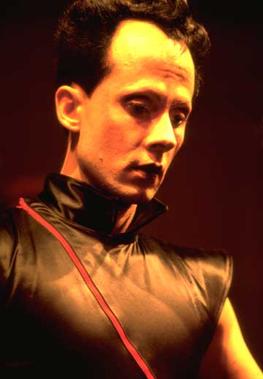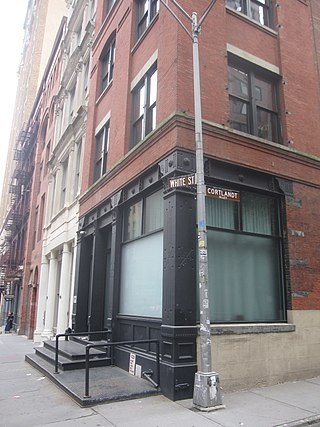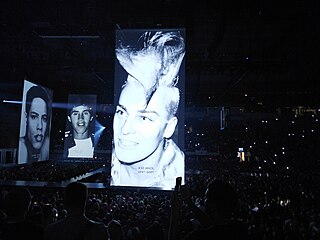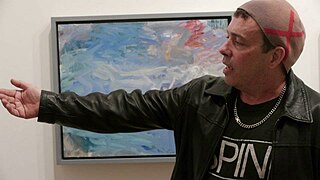
Fred Brathwaite, more popularly known as Fab 5 Freddy, is an American visual artist, filmmaker, and hip hop pioneer. He is considered one of the architects of the street art movement. Freddy emerged in New York's downtown underground creative scene in the late 1970s as a graffiti artist. He was the bridge between the burgeoning uptown rap scene and the downtown No Wave art scene. He gained wider recognition in 1981 when Debbie Harry rapped on the Blondie song "Rapture" that "Fab 5 Freddy told me everybody's fly." In the late 1980s, Freddy became the first host of the groundbreaking hip-hop music video show Yo! MTV Raps.

Klaus Sperber, known professionally as Klaus Nomi, was a German countertenor noted for his wide vocal range and an unusual, otherworldly stage persona.

Marc Shaiman is an American composer and lyricist for films, television, and theatre, best known for his collaborations with lyricist and director Scott Wittman, actor Billy Crystal, and director Rob Reiner. Shaiman has received numerous accolades including two Grammy Awards, two Primetime Emmy Awards, and a Tony Award. He has also received seven Academy Awards nominations.

The Mudd Club was a nightclub located at 77 White Street in the TriBeCa neighborhood of Lower Manhattan in New York City. It operated from 1978 to 1983 as a venue for post punk underground music and no wave counterculture events. It was opened by Steve Maas, Diego Cortez and Anya Phillips.

The Pyramid Club was a nightclub in the East Village of Manhattan, New York City. After opening in 1979, the Pyramid helped define the East Village drag queen, gay, post-punk and no wave art and music scenes of the 1980s. The club was located at 101 Avenue A in Manhattan.

John McLoughlin, better known by the stage name John Sex, was an American cabaret singer and performance artist in New York City from the late 1970s until his death in late 1990.

Ann Magnuson is an American actress, performance artist, and nightclub performer. She was described by The New York Times in 1990 as "An endearing theatrical chameleon who has as many characters at her fingertips as Lily Tomlin does".

Kenny Scharf is an American painter known for his participation in New York City's interdisciplinary East Village art scene during the 1980s, alongside Jean-Michel Basquiat and Keith Haring. Scharf's do-it-yourself practice spanned painting, sculpture, fashion, video, performance art, and street art. Growing up in post-World War II Southern California, Scharf was fascinated by television and the futuristic promise of modern design. His works often include pop culture icons, such as the Flintstones and the Jetsons, or caricatures of middle-class Americans in an apocalyptic science fiction setting.

Frank Holliday is an American painter who became known in the New York City art world in the 1970s and 1980s. He is often associated with the East Village scene and associated with Club 57. His early career as an artist included working with Andy Warhol and close associations with artists such as Keith Haring Ann Magnuson and Kenny Scharf.

Patricia Titchener, known by her stage name Patti Astor, was an American performer who was a key actress in New York City underground No Wave films of the late-1970s. Astor was a key player in the East Village art scene of the early-1980s as she co-founded the instrumental contemporary art gallery, Fun Gallery. Astor also was involved in the early popularizing of hip hop with her performance in Wild Style.

Tseng Kwong Chi, known as Joseph Tseng prior to his professional career, was a Hong Kong-born American photographer who was active in the East Village art scene in the 1980s. He is the brother of dancer/choreographer Muna Tseng.
Area was a themed nightclub that operated from 1983 to 1987 at 157 Hudson Street in Manhattan, New York City. It was a hot spot for celebrities and luminaries of the New York art scene. The club was known for its unusual invitations and changing themes.
SAMO is a graffiti tag originally used on the streets of New York City from 1978 to 1980. The tag, written with a copyright symbol as "SAMO©", and pronounced Same-Oh, is primarily associated with the artist Jean-Michel Basquiat, but was originally developed as a collaboration between Basquiat and Al Diaz.
April Palmieri is an American photographer and musician who performed with a 12-piece all-woman percussion band, Pulsallama. During the early 1980s, the band played at such venues as the Mudd Club, the Pyramid, Danceteria, and Club 57 in New York's East Village. Palmieri's photography from this era, including of Keith Haring and John Sex, has been included in an exhibition at the Tate Liverpool and an exhibition at the Museum of Modern Art (MoMA).

James Allan Curtis, known professionally as Diego Cortez, was an American filmmaker and art curator closely associated with the no wave period in New York City. Cortez was the co-founder of the Mudd Club, and he curated the influential post-punk art show New York/New Wave, which brought the then aspiring artist Jean-Michel Basquiat to fame.

Robert Hawkins is an American artist born in Sunnyvale, California, USA and presently lives in London, UK., Hawkins' is best known for his "ferocious" style of realism. His first drawing in a publication appeared in the kid's section of the San Francisco Chronicle at the age of 5.
The Fun Gallery was an art gallery founded by Patti Astor and Bill Stelling in 1981. The Fun Gallery had a cultural impact until it closed in 1985. As the first art gallery in Manhattan's East Village, it exposed New York to the talents of street art by showcasing graffiti artists like Fab 5 Freddy, Futura 2000, Lee Quiñones, Zephyr, Dondi, Lady Pink, and ERO. Contemporary artists Kenny Scharf, Jean-Michel Basquiat, and Keith Haring also had solo exhibitions at the Fun Gallery.

The Times Square Show was an influential collaborative, self-curated, and self-generated art exhibition held by New York artists' group Colab in Times Square in a shuttered massage parlor at 201 W. 41st and 7th Avenue during the entire month of June in 1980. The Times Square Show was largely inspired by the more radical Colab show The Real Estate Show, but unlike it, was open 24 hours a day, 7 days a week, in what was then a Times Square full of porno theaters, peep shows, and red light establishments. In addition to experimental painting and sculpture, the exhibition incorporated music, fashion, and an ambitious program of performance and video. For many artists the exhibition served as a forum for the exchange of ideas, a testing-ground for social-directed figurative work in progress, and a catalyst for exploring new political-artistic directions.
Suzanne Mallouk is a Canadian-born painter, psychiatrist, and psychoanalyst, based in New York City. She is best known for her role within a core of East Village creatives in the 1980s and for her relationship with artist Jean-Michel Basquiat, much of which her friend Jennifer Clement chronicled in Widow Basquiat: A Memoir. In 2015, Vogue magazine listed Basquiat and Mallouk among "The 21 Most Stylish Art World Couples of All Time."
New York/New Wave was an exhibition curated by Diego Cortez in 1981. Held at the Long Island City gallery P.S.1, it documented the crossover between the downtown art and music scenes. The show featured a coalition of No wave musicians, painters, graffiti artists, poets, and photographers.















